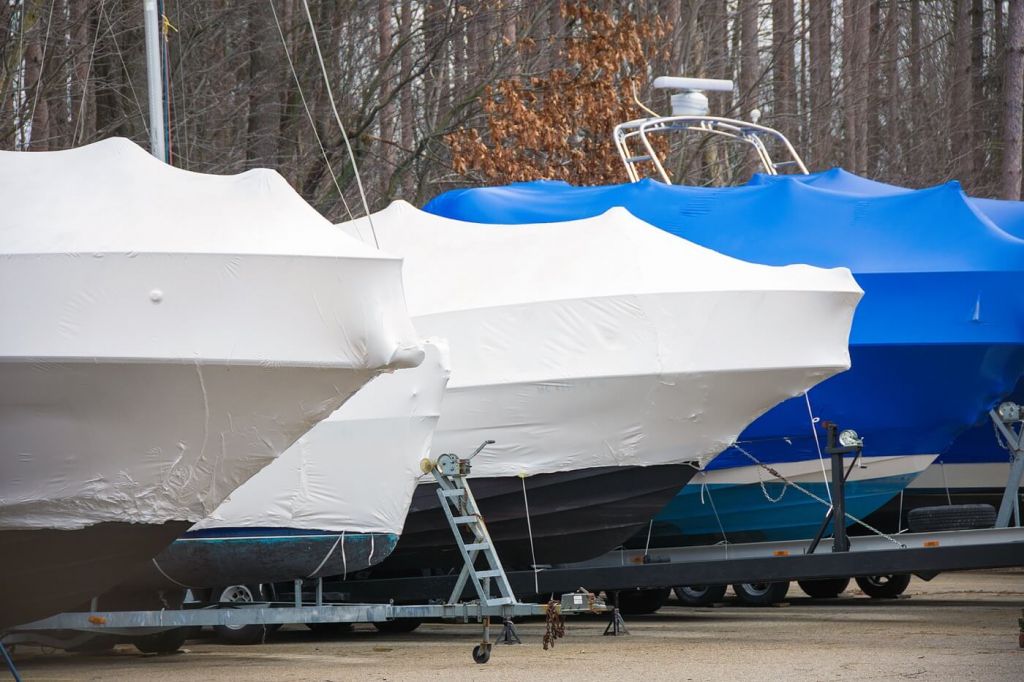Pros and Cons of Shrink Wrapping a Boat - Worth It?
Winter is coming. If you live somewhere temperate, the odds are good you'll get snow, ice and freezing rain during the long, dark non-sailing season. If your boat is anywhere but indoors or under a roof, you'll need a cover.
Is shrink wrapping your boat worth it? Shrinkwrapping your boat is usually a worthwhile investment. If you don't already own a canvas cover and your boat is staying in the elements for the winter, there are many advantages to shrink wrapping versus other methods.

| Pros for shrink wrap | Cons against shrink wrap |
|---|---|
| Best waterproofing | Annual expense, and expensive |
| Keeps snow and ice off the cover | Usually done professionally |
| Covers the whole boat | Ventilation can be a problem |
| Very stable in wind and weather | Zippered doors, vents, etc. are extra |
| Can be customized annually as needed | Not good for long-term layup |
| Smaller upfront cost | Creates plastic waste to be dealt with |
The Pros of Shrink Wrap
To get the most benefit of shrink wrap, it needs to be properly installed. There's an upfront cost for equipment, and framing and installation to survive the rigors of winter takes some skill. So it's not a do-it-yourself project for many, though you can do it.
Some pros of shrink wrapping for the winter include:
- Provides the best waterproof protection. It's plastic, so it doesn't need any special treatment to be water resistant. It shrinks tight, unlike tarps which can only be tied and secured in place. Canvas covers often have more breaks to go around stanchions and hardware which can be leak points.
- Good installation prevents precipitation buildup. Framing under shrink wrap can be set at a high angle to keep ice and snow from accumulating. The slipperiness of the plastic also keeps the ice and snow from building up too quickly. You shouldn't get puddles or snow buildup, both hazards of tarp and canvas covers.
- Covers the entire boat. Most shrink wrap installations cover the entire boat, wrapping the stanchions under the cover and overlapping the top of the hull. Many canvas covers leave holes for stanchions or stop at the cap rails, all of which allows more moisture,
- Very stable when built properly. Framed, supported and tied shrink wrap covers are very resistant to bad weather, rain and snow.
- Can be customized every year. Depending on your needs and expectations you can use a different configuration every year when your boat is wrapped. Planning teak work over the winter? Build the frame higher so you can stand. Wet storing instead of dry this winter? Put the zipper door on the side facing the dock instead of the stern for different access from the dock.
- Smaller upfront cost. The annual cost of shrink wrap is lower than purchasing a permanent cover for your boat. While this is offset by the expense being incurred every year, if you don't have the cash right after you buy a boat or you don't expect to own the boat long enough to recoup the cost of a canvas cover this makes sense.
The Cons of Shrink Wrap
There are disadvantages to shrink wrap, some quite large. Many of the disadvantages can be mitigated with proper installation, and most of the risks and downsides of shrink are caused by improper installation. Correct installation adds to the price, one of the cons.
- It's an annual expense, and it's pricy. Over time, shrink wrapping your boat every year will cost more than buying a custom cover. While the initial cost of a permanent cover is high, you won't be spending any money to cover your boat for the next decade. The average cost of a permanent cover will be much lower over the life of the cover.
- You probably should hire pros. If you already have the skills and the tools, you can save a ton of money. But it's a tricky job, and if you mess it up you will be very unhappy after the first wind or snow storm. You cover one boat a year, a pro team can do several boats a day through decommissioning season - they know how to make a tight, strong cover. You'll be working in a crowded boatyard with a propane fired heat gun and flammable materials. For most boat owners it's not something they tackle themselves.
- Ventilation is a problem. Trapped moisture causes mildew and mold, and polyethylene doesn't allow airflow. Vents must be installed so they don't leak and there is sufficient airflow to prevent mildew.
- Access costs extra. You need to install zipped doors to get to the boat to work on it, so you need to plan ahead. The doors cost extra to buy and for labor to install, but if you remove them carefully, you can usually reuse them. Some installers will credit you for returning intact doors in the spring.
- Not all boats should be shrink wrapped. Shrink wrap can chafe and damage hulls with Awlgrip and other painted finishes. It's not that you can't shrink wrap them, but the wrap can not overlap the hull. So you lose the advantages of a seal which overlaps the hull and deck joint.
- Long Term Layup. If laying up for long term - more than a season - shrink wrap may not hold up as well. If there's a chance that your layup will be longer than one winter, shrink wrap must be watched and may have to be replaced. The polyethylene is UV resistant, but it is not impervious to the effects of long term exposure in the sun.
- Environmental considerations. Shrink wrap generates mountains of plastic waste every spring. It can be recycled, but there is often a small additional cost and effort to dispose of the waste properly.
What are the alternatives?
No discussion on the pros and cons of boat shrink wrap is complete without looking at other options for covering your boat. Shrink wrap works well for most wintery regions, but there are other considerations when choosing your boat cover. These include your budget, the prevailing winds and expected weather and storms, the size of your boat, and where and how you'll be storing it.
Custom Canvas
Almost any permanent cover you buy for your boat will be a custom purchase tailored to your sailboat. Holes for standing rigging, stanchions, radar arches, and other off deck items are cut into it. Canvas covers have their own set of pros and cons to consider, and one might be more appropriate for you.
- Permanent covers are reusable, so the cost is spread over many years of winterizing and storage. This makes the cost per season much lower than shrink wrap if your cover lasts. If you plan to own your boat for many years, this makes a compelling case for a cover.
- Canvas is environmentally friendly and doesn't make heaps of plastic trash.
- You put it up yourself. With friends, it you're lucky because extra hands help and it can be awkward for one person to deal with steel framing and heavy canvas.
- The boat gets good ventilation over the winter.
Canvas has its downsides.
- Higher up front cost. A custom canvas product is never cheap, and it must be measured and fitted to your boat.
- It doesn't shed water and snow as well as shrink wrap.
- Canvas doesn't keep water out like shrink wrap, and it's more likely to leak.
- It may need maintenance and repairs between winters.
- You must store it. A big pile of canvas and steel tubes is an awkward thing in the garage or basement.
Tarps and Ropes
Off the shelf plastic tarpaulins tied down with ropes is a very popular budget alternative. The absolute cheapest (and worst) way this is done is just wrapping tarps over a boat's open areas and tying it down at the corners.
For small boats, a tarp and rope cover can work. Once a boat gets big enough to consider leaving the rig up for the winter it is a less desirable alternative. If you must use tarps, consider building a frame over the boat to tie the tarp too. It will minimize chafe, allow for tighter attachment of the tarp, and provide some protection against snow buildup if you can slope the top.
The list of pros for a tarp cover is easy.
- It's very inexpensive.
- You can do it yourself.
- If you built a frame under it and make it very tight, it may last the season.
The disadvantages are many.
- Prone to loosening, blowing and failure.
- Gaps between tarps can't easily be sealed, so if you can't get one tarp big enough for the whole boat leaks are inevitable.
- Can't be tightened down and stretched taut enough to prevent flapping, blowing, loosening, and wear.
- Won't be a tight and precise fit for the contours and hardware of the boat.
- Won't repel snow or ice buildup well.
- Because they are hard to stretch and tighten, they are for more prone to failure in high winds and inclement weather than other covers.
Indoor Storage
If your boat is small enough or you can afford it, indoor storage makes any cover unnecessary. It can be very expensive if it's anything but your own garage or barn, but nothing will keep your boat cleaner and safer for the winter.
Who needs shrink wrap?
Everyone who stores a boat for the winter outdoors should consider it. If you already have a winter cover for your boat, you're exempt. For smaller boats it may make less economic sense, but if your objective is to prevent damage to your boat and come back to a clean vessel in the spring, you should get a quote.
There may be one condition where canvas cover owners could consider shrink wrapping - if they store the boat some place different for a season. If the entrance flaps to your canvas cover work on hard stands but don't allow you to get on the boat from a dock you'll have problems using it if you decide to wet store for a season.
So do you need to shrink wrap?
The answer comes down to your boat, your budget, and where you store it. Are you up in the Pacific Northwest where it rarely freezes and snows even less? Or are you in southern New England where a freeze and a pile of snow is almost inevitable? If you plan to work on your boat over the winter or get out and use it if you have mild winters that is also a factor.
If any of the following are true you should consider the pros of shrink wrap.
- You store your boat outdoors in an area prone to snow and ice.
- The boat doesn't already have a reusable winter cover.
- You can't afford the cash outlay to buy a canvas winter cover this year.
- The boat is big enough that you'll store it with the mast up.
- Windy conditions are common where you store the boat.
- You don't know if you'll own the boat long enough to recoup the cost of a canvas cover.
Did you find the answer to your specific question?
👍 16 👎 4


Comments
John Roda
thank you!
Ella Starr
How helpful that you talk about how permanent covers are reusable. I am getting my first sea ray boat this summer. I will find a good sea ray factory original canvas. https://searaycanvas.com/
Leave a comment